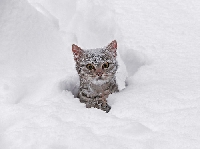
Tips for cats and cold weather and protecting pets from the elements
The winter months can be hard on people and pets alike. Pet owners and animal lovers all know that snow, ice, chilling winds, and dropping temperatures can be particularly harsh for cats, who are often considered to be ?outdoor? pets during other season.
It is important to take precautions when it comes to the subject of cats and cold weather, as leaving a cat outdoors and unattended during the winter may jeopardize the health and the life of beloved family pets.
Cats and Cold Weather Don’t Mix! Seven Tips for Pet Owners
1. If you are a pet-owner with an outdoor cat, it is important to realize that cats who spend time outdoors in the winter will need more food, because keeping warm depletes their energy. Changing feeding habits during the winter is a must. Whether you serve your pet dry or wet food, a high quality holistic cat food is especially good when the weather is harsh. Be sure to provide enough to satisfy their hunger. If feedings are generally twice a day, you may need to increase the frequency to three feedings during the coldest winter months.
~
2. Adding essential fatty acids and other fat-rich supplements to a cat’s diet during the winter months will fortify and thicken the animal’s coat and fatty layer of protection. Salmon oil which most cats adore, is an ideal ingredient to mix with regular feedings. Check into fish oil supplements made for cats. Butter, soybean oil, or other vegetable oils are also beneficial
3. Keep your feline friends well groomed during the winter months, as matted fur won’t properly protect pets from the cold weather. In fact, tangled, matted fur will increase an animal’s risk for frostbite and hypothermia.
4. Clean and towel dry the fur of your feline friends after they have been outdoors in sleet or snow. Damp or icy fur can contribute to hypothermia and illness, particularly in very old, or very young cats. Be sure to towel dry the feet and toes of cats, as clumps of ice and snow frequently ball up between the paw pads, which can cause discomfort, as well as frostbite.
5. Do not leave a cat outdoors for any considerable length of time during blizzards, ice storms or during periods when the wind chill factor brings temperatures below zero.
6. If you do have an outdoor cat, or if you care for stray cats that may be too skittish to enter a house, set up an outdoor shelter to give these animals some added protection. Turn the opening of the shelter away from the direction of prevailing winds. Add insulation to the shelter by raising the floor of the shelter off of the frozen ground; then add blankets, or even just layers of cardboard.
7. In regard to cats and cold weather, there is one other issue that pet owners often do not consider. When cats come back in from the cold, they will seek out a heat source. During those chilly winter months, many cats will be inclined to curl up by a fireplace. Pet owners must be extra cautious about winter fires in the hearth, and should keep open fires screened. Stray sparks and embers from a fire can ignite on the fur of a pet who is simply seeking warmth.
